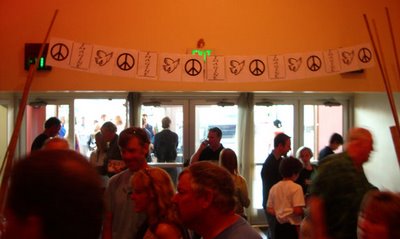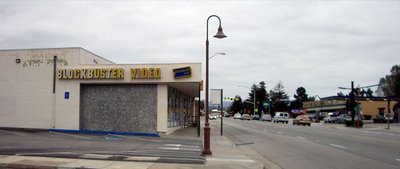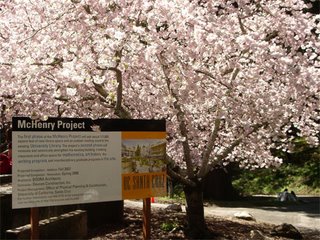
I arrived at Kresge College in early October 1977. The first three or four days of classes it rained almost non-stop. I remember sitting in the Idler cafe (next to the
Kresge Town Hall) reading and looking out at the redwoods in the rain.
During our orientation weekend the architect who designed Kresge spoke to our class (this must have been Charles Moore,
http://www.bluffton.edu/~sullivanm/moorekresge/kresge.html ). [Apparently this was more likely Bill Turnbull, see:
http://www.well.com/~abs/Cyb/4.669211660910299067185320382047/c3m_0311.txt for some very interesting commentary on Kresge from the years just before I got there. I just found this link a few days ago.] He said that the original inspiration for Kresge was a small Mediterranean village. The exterior walls were to be covered with wood shingles and the street down the middle was to be cobblestone. there were fountains distributed throughout the college, connected by a small stream that flowed from one end of the school to the other.
But during the construction of the college the Kresge foundation said that it was costing too much money so the shingles and cobblestones were replaced with stucco and asphalt. I don't know if the project was over budget or what but we students always assumed that they were just cheap. This fit into our idea of the Kresge foundation since Kresge is the "K" in Kmart, home of the blue light special.
The fountains were turned off during the water shortage of the early 70s. One or two of them at the bottom of the college have been turned back on from time to time but the one at the top of the college has been removed. It was in the center of the courtyard between the Town Hall and the cafe with wooden benches around it and a wooden cover that could be put over it when it was not in use. It was replaced with a very nice bronze plaque made by Kresge alum and Santa Cruz bronze artist Sean Monaghan (sp?).
The architect said that he had gotten quite a bit of flak for the design of the "suites", one of the three types of apartments at Kresge. the suites originally had 8 bedrooms surrounding a large central bathroom with two toilet stalls, a large shower enclosure with two shower heads and a larger main part of the room with sinks and mirrors.
Since the only other rooms were bedrooms (mostly singles of fairly modest size), the bathrooms ended up being the place the students would congregate. Moore attributed the fact that the bathroom was so huge and central to the fact that he had grown up during the anal retentive 1950s which had somehow subconciously influenced his design.
Two of the single rooms in each of the suites have since been converted to a kitchen and a living room but the bathrooms still end up being natural gathering spots. When I was a student there, one of the key pieces of furniture in the apartments was large foam chairs, basically a 6' cube of foam with a notch cut out of it and tucked in and a cloth cover over it. These were some of the most comfortable chairs I have ever sat in and each one held two people comfortably if they liked cuddling up. In at least on of the suites the students moved these chairs into the bathroom which became a very comfortable place to hang out. The one suite I remember which was set up this was had white sheets coveering the walls with a "light organ" with colored lights which would change in time to the music on their stereo.
The other main piece of furniture were "palasets" (sp?). These were 70's Danish modern plastic cubes about 16" on a side. Some were cupboards with doors, some open shelves. They could be stacked and connected in any combination to make bed frames, desks, etc. I think I made a bed loft of mine and put my desk below it. Oh yes, there were also wooden desks and chairs, some of which I have seen for sale from UC surplus recently for $5 apiece. They were quite nice, well built oak desks that seemed to stand up to anything.
The other two types of apartments were "flats" with two twin rooms , a large living room and a kitchen nook and the "Sextets", multi-level apartments without any walls except for the bathroom. I believe they were called sextets because they held six students but given the culture of Kresge at that time I always imagined it had to do with sexual experimentation. One of my first year roommates said he got an invitation to an orgy in the sextets in his mailbox. He looked in on it and said that it wasn't really very interesting.
The first year that I was at Kresge I lived in R-6, in the top left suite. Later on I was in a suite in R-8 which was called "The Zoo" because the lower level was a long row of rooms with sliding glass doors right on the street so people would always look in as they walked by. . At that time all of the buildings had names. R-9 or 10 was called "bittersuite". R-3 was "the corner of the college" It was specifically designated as an internationally oriented building and a social hub. The sextets were just the sextets. I wish I could remember what the rest of them were. If anyone does, please post.
[Along with the above mentioned link to the article on The Well by Scrivener, I also have just found a number of articles in the Special Collections section of the McHenry library about the early years at Kresge. Apparently I got there in 1977 just as the original experiment of Kresge was in its last throws of dying (or being killed depending on who you ask) several of the main reasons that I went to UCSC had vanished a few years before or were just ending unbeknownst to me. I had often wondered why Kresge and UCSC were so different from the way I thought they would be and am only finding out the more interesting reasons for this right now. ]








































